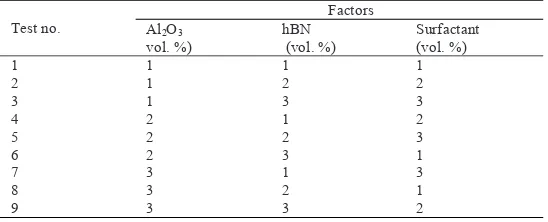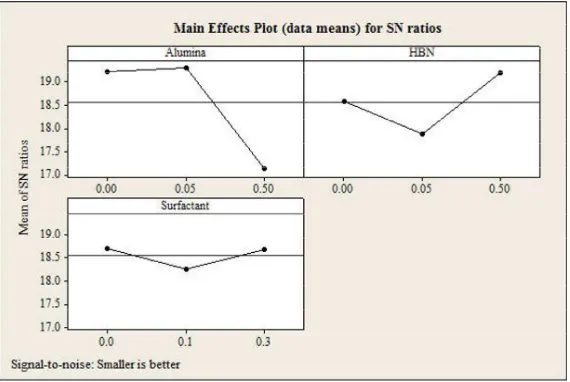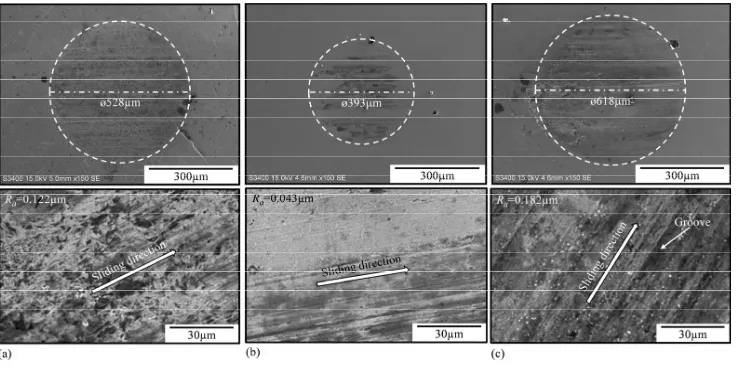Procedia Engineering 68 ( 2013 ) 313 – 319
1877-7058 © 2013 The Authors. Published by Elsevier Ltd.
Selection and peer-review under responsibility of The Malaysian Tribology Society (MYTRIBOS), Department of Mechanical Engineering, Universiti Malaya, 50603 Kuala Lumpur, Malaysia
doi: 10.1016/j.proeng.2013.12.185
ScienceDirect
The Malaysian International Tribology Conference 2013, MITC2013
Optimization of Tribological Performance of
hBN/AL
2O
3Nanoparticles as Engine Oil Additives
Muhammad Ilman Hakimi Chua Abdullah
a, Mohd Fadzli Bin Abdollah
a,b*, Hilmi
Amiruddin
a,b, Noreffendy Tamaldin
a,b, Nur Rashid Mat Nuri
a,baFaculty of Mechanical Engineering, Universiti Teknikal Malaysia Melaka, Hang Tuah Jaya, 76100 Durian Tunggal, Melaka, Malaysia bGreen Tribology and Engine Performance Research Group (G-TriboE), Universiti Teknikal Malaysia Melaka,
Hang Tuah Jaya, 76100 Durian Tunggal, Melaka, Malaysia
Abstract
The purpose of this study is to determine the optimal design parameters and to indicate which of the design parameters that are statistically significant for obtaining a low coefficient of friction (COF) with hexagonal boron nitride (hBN) and alumina (Al2O3)
nanoparticles, dispersed in conventional diesel engine oil (SAE 15W40). Design of experiment (DOE) was constructed using the Taguchi method, which consists of L9 orthogonal arrays. Tribological testing was conducted using a four-ball tester according to
ASTM standard D4172 procedures. According to the analysis of signal-to-noise (S/N) ratio and analysis of variance (ANOVA), COF and wear scar diameter were reduced significantly by dispersing several concentrations of hBN nanoparticles in conventional diesel engine oil, compared to without nanoparticles and with Al2O3 nanoparticle additive. Contribution of 0.5
vol.% of hBN and 0.3 vol.% of oleic acid, as a surfactant, can be an optimal composition additive in conventional diesel engine oil, to obtain a lower COF. In addition, the predicted value of COF by utilizing the levels of the optimal design parameters (0.5 vol.%hBN, 0.3 vol.% surfactant),as made by the Taguchi optimization method, was consistent with the confirmation test (average value of COF = 0.07215), which fell within a 95% confidence interval (CI).
© 2013 The Authors. Published by Elsevier Ltd.
Selection and peer-review under responsibility of The Malaysian Tribology Society (MYTRIBOS), Department of Mechanical Engineering, Universiti Malaya, 50603 Kuala Lumpur, Malaysia. Keywords: hBN nanoparticles; Al2O3 nanoparticles; Four-ball testing; Friction Coefficient; Taguchi method.
1.Introduction
Nanoparticles can be considered as modern lubricant additives. They present several major advantages over organic molecules that are currently used as lubricant additives. Their nanometer size allows them to enter into the contact area like molecules. They are immediately efficient; even at ambient temperatures. Therefore, no induction period is necessary to obtain interesting tribological properties. Various types of nanoparticles were used to prepare nano lubricants, including polymers, metals, and organic and inorganic materials [1-4].
_________
* Corresponding author. Tel.: +6-06-234-6805; fax: +6-06-234-6884
E-mail address: [email protected]
© 2013 The Authors. Published by Elsevier Ltd.
Studies reported that copper (Cu) nanoparticle used as oil additives can improve the anti-wear, load-carrying, and friction-reduction performance of SJ 15W/40 gasoline engine oil [5]. This was in agreement with several other authors’ work, where they used nanoparticles of zirconia/silica (ZrO3/SiO2) composite, copper oxide (CuO),
titanium oxide (TiO2), and nano-diamond as oil additives [6-8]. Even the addition of a low concentration of nanoparticles (between 0.2% and 3% vol.) into lubricating oil is sufficient to improve tribological properties [9]. Qiu et al. [10] found that a concentration of nickel (Ni) nanoparticle between 0.2 and 0.5% provided the best anti-wear behavior and friction reduction. Tao et al. [11] demonstrated that 1% was considered the optimum concentration for diamond nanoparticle in paraffin oil.
The need to improve fuel economy, while reducing emissions, is constantly motivating the demand for research to increase engine performance by improving the lubricants. Nanoparticles are well recognized as being promising additives that reduce friction and wear; with respect to current conventional lubricant oil. A variety of mechanisms have been proposed to explain the lubrication enhancement of nanoparticle-suspended lubrication oil, including the ball bearing effect, protective film, the mending effect, and the polishing effect. In Malaysia, no study has been carried out thus far to investigate the potential of a combination of hBN/Al2O3 nanoparticles, used as diesel engine
oil additives. Therefore, it is imperative to investigate the tribological performance of hBN/Al2O3 nanoparticles
dispersed in conventional diesel engine oil. Good lubrication and thermal conductivity properties, which can simultaneously improve tribological performance and boost heat transfer in engines, were the key factors in using hBN and Al2O3. Furthermore, both types of nanoparticles are environmentally friendly.
2.Experimental procedures
2.1. Design of Experiment (DOE)
In this study, the Taguchi method consisting of L9 orthogonal arrays was used, with nine rows (corresponding to
the number of tests), and three columns at three levels. This array has eight Degrees of Freedom (DOF), in which six are assigned to three factors (each one has two DOF), and two DOF were assigned to errors. In order to observe the degree of significant of the design parameters in vol.% contributions, three factors (each at three levels), were taken into account (as shown in Table 1). COF values corresponding to each experiment are shown in Table 2. Table 2 also shows the DOE with L9 orthogonal arrays using Minitab statistical software.
Table 1. HBN/Al2O3 contents and experimental condition: three parameters and three levels.
Level
Parameters Alumina
(vol.%)
hBN (vol.%)
Surfactant (vol.%)
1 0 0 0
2 0.05 0.05 0.1
3 0.5 0.5 0.3
Table 2. DOE with L9 (33) orthogonal arrays.
Test no.
Factors Al2O3
vol. %)
hBN (vol. %)
Surfactant (vol. %)
2.2. Samples preparation
Based on the DOE shown in Table 2, where the brand of diesel engine oil could be a noise factor, nano-oil samples were prepared by dispersing several concentrations of 70nm sized hBN and Al2O3 in two different brands
of conventional diesel engine oil (SAE 15W40).The samples could be stabilized with only the addition of an appropriate amount of surfactant (oleic acid). The mixture of solid particles in diesel engine oil was homogenized for 20 minutes using an ultrasonic homogenizer (Sartorius Labsonic P) with 50% amplitude and 0.5 active time interval.
2.3. Tribological test
According to Table 2, tribological testing was carried to determine the COF using a four-ball tester (TR 20). Testing followed ASTM standard D4172 procedures. The speed, load, time, and temperature were 1200 rpm, 392.4N, 3600 secs, and 75oC, respectively. Within the four-ball tester, three 12.7 mm diameter carbon-chrome steel balls were clamped together and covered with lubricant for evaluation. Fourth steel ball (of the same diameter), referred to as the top ball, was held in a special collet inside a spindle, and rotated by an AC motor. The top ball was rotated in contact with the three fixed balls, which were immersed in the sample oil.The COF was recordedusing a data terminal processing system. Detailed mechanical properties of the balls are shown in Table 3.
Table 3. Mechanical properties of material.
Properties Ball bearing (Carbon-chromiumsteel)
Hardness (H), HRC 61
Density (U), g/cm3 7.79
Surface roughnessRa, μm 0.022
3.Results and discussion
3.1. Analysis of the S/N ratio
According to Taguchi method studies, response variation using the S/N ratio is important, because it can result in the minimization of quality characteristic variation, due to uncontrollable parameters. The COF was considered as being the quality characteristic, using the concept of “the smaller-the-better”. The S/N ratio used for this type response was given by:
¸¸ ¹ · ¨¨ © §
¦
n y N
S
2 10
log 10
/ (1)
Table 4. COF values and S/N ratio values for test run.
Test no. Respond (COF) S/N ratio
Brand A Brand B (dB)
1 0.0884 0.1389 18.6812
2 0.1476 0.0726 18.6866
3 0.0593 0.1227 20.3204
4 0.1325 0.0746 19.3705
5 0.1580 0.0804 18.0370
6 0.0936 0.0939 20.5596
7 0.0972 0.1565 17.7042
8 0.1506 0.1340 16.9204
9 0.1511 0.1393 16.7532
Although conventional diesel engine oil containing Al2O3 nanoparticleshowed a greater influence on the S/N
ratio, it affected the negative impact, where the COF increased significantly with the Al2O3 concentration. This was
because the Al2O3 nanoparticlethemselves made tiny grooves on the contact surface (Fig. 2(c)), which may be
formed by the ploughing effect of harder Al2O3 nanoparticle, resulting in an increase in surface roughness (Ra = 0.182 μm). However, the COF decreased significantly with hBN concentration. To some extent, this suggests that hBN nanoparticles effectively played the role of ball bearings; where the sliding friction was changed into rolling friction between the friction pair, resulting in reducing the contact area between the frictional surfaces.Furthermore, Fig. 2 shows that a smoother worn surface (Ra = 0.043μm) was also obtained due to the polishing effect of lubrication containing hBN nanoparticles.This is in accordance with a significant reduction of wear scar diameter. These resultsshowed that the conventional diesel engine oil containing a certain amount of hBN nanoparticle could reduce both friction and wear in the friction pairs.
Fig. 2. SEM micrograph of worn surfaces on the ball under lubricated conditions of (a) conventional diesel engine oil, (b) with 0.5 vol. % of hBN additive, and (c) with 0.5 vol. % of Al2O3 additive.
3.2. Analysis of Variance (ANOVA)
ANOVA is statistically based, used for detecting differentials occurring in the average performance of groups of items tested. ANOVA helps in formally testing the significance of all main factors and their interactions by comparing the mean square against an estimate of the experimental errors at specific confidence levels. First, the total sum of squared deviations SSTfrom the total mean S/N ratio nm is calculated as follows:
2 1¦
n
i i m
T n n
SS (2)
Where,nis the number of experiments in the orthogonal array and nmis the mean S/N ratio for theiexperiment.The percentage contribution P can be calculated as:
T d SS SS
P (3)
Where,SSd is the sum of the squared deviations. The ANOVA results are shown in Table 5.
A function known as theF test, which was named after Fisher [12], uses F to see the most significant effect on design parameters, based on the quality characteristic. The F-ratio is a ratio of the mean square error to the residual error, and is traditionally used to determine the significance of a factor.
The P-value usually reports the significance level, which shows either a suitable or an unsuitable level for the optimization (as shown in Table 5). Contribution (in unit %) is defined as the significance vol.% parameter on COF performance. Tables 5(a) and (b) show that the contribution percentage of hBN gave a more significant S/N ratio compared to the means, which obtained 18.01% compared to 10.01%. In contrast, contribution percentage of surfactant was obtained by both ANOVA for mean and ANOVA for S/N ratio, had little effect. In addition, Al2O3showed more significance on the ANOVA for mean compared to the S/N ratio. However, the behavior of the
Al2O3itself could create higher surface roughness on the contactsurfaces and significantly increasethe COF.
Therefore, it would be wise to eliminate the Al2O3.This indicates that the addition of hBN and surfactant has
Table 5(a). ANOVA for COF S/N ratios.
Table 5(b). ANOVA for COF Means.
Source of Variation DOF
Sum of
The confirmation test was the final stage to verify the results obtain from the Taguchi design approach. The confirmation test is a crucial step and is highly recommended by Taguchi to verify test results [13]. In this study, several confirmation tests were performed by utilizing the levels of the optimal design parameters (0.5 vol. % hBN, 0.3 vol. % surfactant). Table 6 shows that an average value of COF (0.7215) falls within the 95% CI. Therefore, the predicted value of COF made by the Taguchi optimization method was consistent with the confirmation test. The CI can be calculated as: the variance of the error term (from ANOVA), andNeis the effective number of replications:
condition
Variable n Predicted
value
Experimental
4.Conclusions
COF and wear scar diameter have been reduced significantly by dispersing several concentrations of hBN nanoparticle in conventional diesel engine oil. This was because of the hBN nanoparticle made both “ball bearing effect” and “polishing effect”, by changed the sliding friction into rolling friction between the friction pair and consequently smoothing the rough friction contact surfaces. Moreover, the negative effect of friction reduction and wear was observed in conventional diesel engine oil containing Al2O3 nanoparticle due the ploughing effect of
harder Al2O3 nanoparticle. It was found that a contribution of 0.5 vol.% of hBN and 0.3 vol.% of oleic acid as a
surfactant can be used as an optimal additive composition in conventional diesel engine oil, to obtain a lower COF. The predicted value of COF by utilizing the levels of the optimal design parameters (0.5 vol. % hBN, 0.3 vol. % surfactant), as made by the Taguchi optimization method, was consistent with the confirmation test (average value of COF = 0.07215), which fell within a 95% CI.
Acknowledgements
The authors gratefully acknowledge Prof. Dr. Jaharah Binti A. Ghani for her surface roughness measurement assistance. This research was supported by grant numbers [PJP/2012/FKM(40A)/S01044, PJP/2012/FKM(11A)/S01086, and FRGS/2013/FTK/TK06/02/3/F00166], as awarded by Universiti Teknikal Malaysia Melaka (UTeM) and the Ministry of Higher Education Malaysia (MOHE).
References
[1] Wu, Y.Y., Tsui, W.C., Liu, T.C., 2007. Experimental analysis of tribological properties of lubricating oils with nanoparticle additives, Wear 262, p. 819.
[2] Xiaodong, Z., Xun, F., Huaqiang, S.,Zhengshui, H., 2007. Lubricating properties of Cyanex 302-modified MoS2 microspheres in base oil 500SN, Lubr. Sci. 19, p. 71.
[3] Liu, G., Li, X., Qin, B., Xing, D., Guo, Y., Fan, R., 2004. Investigation of the mending effect and mechanism of copper nano-particles on a tribologically stressed surface, Tribol. Lett. 17, p. 961.
[4] Lee, K., Hwang, Y., Cheong, S., Choi, Y., Kwon, L., Lee, J., Kim, S.H., 2009. Understanding the role of nanoparticles in nano-oil lubrication, Tribol Lett. 35, p. 127.
[5] Zhang, M., Wang, X., Liu, W., Fu, X., 2009. Performance and anti-wear mechanism of Cu nanoparticles as lubricating oil additives, Industrial Lubrication and Tribology 61 (6), p. 311.
[6] Li, W., Zheng, S., Cao, B., 2011. Friction and wear properties of ZrO2/SiO2 composite nanoparticles, Journal of Nanoparticle Research 13 (5), p. 2129.
[7] Wu, Y.Y., Tsui,W.C., Liu, T.C., 2007. Experimental analysis of tribological properties of lubricating oils with nanoparticles additives, Wear 262, p. 819.
[8] Rapoport, L., Leshchinsky, V., Lvovsky, M.,Nepomnyashchy, O., Volovik, Y., Tenne, R., 2002. Mechanism of friction of fullerenes, Ind. Lubr. Tribol. 54, p. 171.
[9] Hwang, Y., Lee, C., Choi, Y., Cheong, S., Kim, D., Lee, K., Lee, J., Hyung Kim, S., 2011. Effect of the size and morphology of particles dispersed in nano-oil on friction performance between rotating discs, Journal of Mechanical Science and Technology 25 (11), p. 2853. [10] Qiu, S., Zhou, Z., Dong, J., Chen, G., 2001. Preparation of Ni nanoparticles and evaluation of their tribological performance as potential
additives in oils, J. Tribol. 123, pp. 441.
[11] Tao, X., Jiazheng, Z., Kang, X., 1996. The ball-bearing effect of diamond nanoparticles as an oil additive, J. Phys. D 29, p. 2932. [12] Ross, P. J., 1996. Taguchi techniques for quality engineering, McGraw-Hill International Editions, Singapore.




